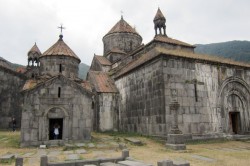Haghpat and Sanahin Monasteries
Haghpat and Sanahin Monasteries
Masterpieces of religious architecture and major intellectual centers in the Middle Ages, the monasteries of Haghpat and Sanahin, in the northern Lori province, where the first sites in Armenia to be placed on UNESCO's World Heritage List in 1996. They were chosen as World Heritage Sites because they represent the pinnacle of Armenian religious architecture, whose unique style blends elements of Byzantine ecclesiastical architecture and the traditional architecture of the Caucasus region.
Both monasteries were founded in the 10th century. There are striking similarities between these two masterpieces, not only in their compositional features but in the architectural details and decorations of their monuments.
Their many similarities and their proximity to one another (Haghpat can actually be seen from Sanahin) inevitably led early pilgrims to compare the two monasteries and a friendly rivalry was created between them. In fact, their modern names developed through this rivalry. Haghpat means a huge wall, referring to one of its striking features, and Sanahin means older than others. (Since the exact dates of their foundation were unclear, parishioners of each monastery claimed theirs to be the oldest.)
Unique and Powerful Religious Art of Haghpat and Sanahin Monasteries
The 13th century the Amenaprkitch (all savior) khachkar at Haghpat Monastery depicts Jesus on the cross along with a number of realistic human figures fitted into the unique composition of its pattern. Aside from its incredible detail-oriented design, Amenaprkitch is considered an outstanding work of Armenian art because it is one of the few khachkars ever carved that depicts Jesus on the cross. Many pilgrims, who believe that the All Savior khachkar has healing powers, come to Haghpat seeking inspiration from this marvel of religious art.
Between the 10th and the 13th centuries, Haghpat and Sanahin Monasteries were expanded to include more than 20 churches and chapels, four annexes mausoleums, bell towers, academic buildings, book depositories, dining halls, galleries, bridges, and other monumental structures.
In these monasteries, the humanities, sciences, and medicine were studied, treatises were written, and miniatures painted. Haghpat and Sanahin are especially rich in khachkars, over 80 of which have survived. They were intended not only as memorials but to mark special occasions and to encourage philanthropy. (Names of donors were often carved into khachkars.)
Marked by the unity and compactness of their asymmetric layouts, Haghpat and Sanahin, the rival monasteries of Lori province, had a tremendous influence on the development of Medieval Armenian architecture.










